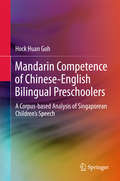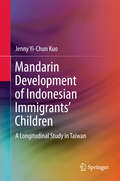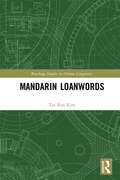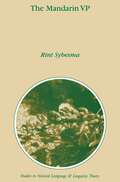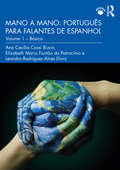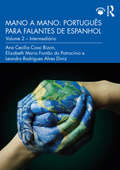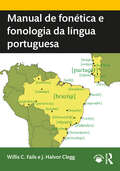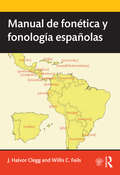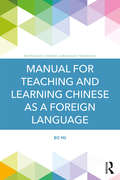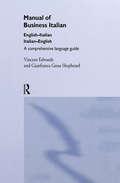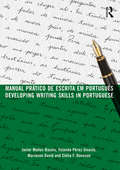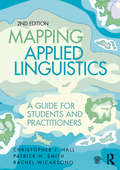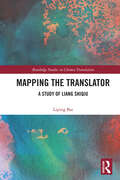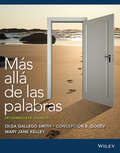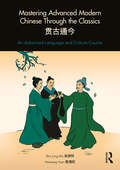- Table View
- List View
Mandarin Competence of Chinese-English Bilingual Preschoolers: A Corpus-based Analysis of Singaporean Children’s Speech
by Hock Huan GohThis book provides readers with a detailed sketch of the Mandarin competence of Chinese children in Singapore from different home language backgrounds. Their Mandarin competence is defined in terms of lexical diversity, syntactic complexity and code-switching tendency. The findings presented show that there are statistical differences in lexical diversity and syntactic complexity among the compared groups of children, and these differences in linguistic competence were found to be positively correlated to increased Mandarin exposure at home. They also demonstrate that there are statistical differences in code-switching tendency among the groups of children compared, which were found to be negatively correlated to increased exposure to Mandarin at home. A general relationship between home language exposure and Mandarin competence was established, although this relationship was found to be volatile, especially among children who are more bilingually exposed. This book shares these findings with linguists, language educators, and language policymakers, both local and international.
Mandarin Development of Indonesian Immigrants’ Children: A Longitudinal Study in Taiwan
by Jenny Yi-chun KuoThis book summarizes the results a three-year longitudinal project on Mandarin development among children of Indonesian mothers, the second largest non-Mandarin speaking immigrant group in Taiwan. These children were acquiring their first language while interacting primarily with a non-native learner of the language. The book discusses phonological, lexical and syntactic development to provide a better understanding of the language development of the children of immigrants and has important implications for language education policy and language acquisition theories.
Mandarin Loanwords (Routledge Studies in Chinese Linguistics)
by Tae Eun KimEnglish-based Mandarin loanwords are commonly used in Chinese people’s daily lives. Mandarin Loanwords demonstrates how English phonemes map into Mandarin phonemes through Mandarin loanwords adaptation. The consonantal adaptations are the most important in the analyses, and vowel adaptation and tonal adaptation is also considered. Through the analysis, it is proven that the functions of phonology and phonetics play a significant role in Mandarin loanword adaptation, however the functions of other factors, such as semantic functions of Chinese characters and English orthography, are also discussed. Additionally, the phonetic symbolization of Chinese characters is mentioned.
Mandarin Loanwords (Routledge Studies in Chinese Linguistics)
by Tae Eun KimEnglish-based Mandarin loanwords are commonly used in Chinese people’s daily lives. Mandarin Loanwords demonstrates how English phonemes map into Mandarin phonemes through Mandarin loanwords adaptation. The consonantal adaptations are the most important in the analyses, and vowel adaptation and tonal adaptation is also considered. Through the analysis, it is proven that the functions of phonology and phonetics play a significant role in Mandarin loanword adaptation, however the functions of other factors, such as semantic functions of Chinese characters and English orthography, are also discussed. Additionally, the phonetic symbolization of Chinese characters is mentioned.
The Mandarin VP (Studies in Natural Language and Linguistic Theory #44)
by Rint SybesmaThe Mandarin VP deals with a number of constructions in Mandarin Chinese which involve the main verb and the material following it, like the object NPs, resultative phrases, durative expressions and other elements. The basis claim defended in this book is that all elements that follow the main verb in a Mandarin sentence form one single constituent which functions as the complement of the verb. The Mandarin VP offers new and original analyses of such hot issues as resultative constructions, the ba-construction and verb-le. In addition, the conclusions drawn from the research into Mandarin syntax are discussed in more general theoretic terms, which leads to original proposals regarding the internal make-up of accomplishments and the status of Theta Theory. The research reported on in this book was concluded within the bounds of mainstream generative theorizing. The Mandarin VP is of interest to all syntacticians, especially those interested in Chinese.
Mano a Mano: Volume 1 – Básico (Mano a mano: português para falantes de espanhol)
by Ana Cecília Cossi Bizon Elizabeth Maria Fontão do Patrocínio Leandro Rodrigues Alves DinizMano a Mano: Português para Falantes de Espanhol vem preencher uma importante lacuna no mercado editorial: a carência de livros didáticos que, considerando as necessidades específicas de falantes de espanhol, favoreçam um desenvolvimento mais rápido de sua proficiência em português. A coleção reúne uma série de características favoráveis à aprendizagem do português em diferentes contextos (ensino médio, universidades, cursos livres): Convida o(a) aluno(a) a desenvolver sua proficiência em português ao mesmo tempo que forma uma imagem multifacetada do Brasil, em diálogo com suas próprias construções culturais, desconstruindo discursos estabilizados e ampliando seus horizontes; Favorece o trânsito por múltiplas práticas de letramento, em que circulam diferentes gêneros discursivos, oferecendo oportunidades para que o(a) estudante aprimore suas capacidades de linguagem em contextos reais, ou próximos a situações autênticas de interação; Sensibiliza o(a) aluno(a) para diferentes variedades da língua portuguesa; Permite ao(à) estudante desenvolver suas capacidades léxico-gramaticais e fonético-fonológicas de maneira reflexiva e contextualizada, levando em consideração necessidades específicas de falantes de espanhol; Propõe tarefas semelhantes às encontradas no Certificado de Proficiência em Língua Portuguesa para Estrangeiros (Celpe-Bras), do Ministério da Educação brasileiro; É acompanhado por dois cadernos complementares integrados, com explicações detalhadas referentes a recursos léxico-gramaticais e fonético-fonológicos, além de uma série de atividades; Disponibiliza online os vídeos e áudios de tarefas de compreensão oral e de atividades de pronúncia. Preparado para o desenvolvimento de um curso de até 60 horas em contexto de imersão, ou 90 horas de não-imersão, Mano a Mano, Volume 1 – Básico permite levar falantes de espanhol (como língua materna ou estrangeira/adicional) que nunca tiveram contato significativo prévio com o português até o início do nível Intermediário do Celpe-Bras, do B1 do Quadro Europeu Comum de Referência para as Línguas, ou do Intermediário Médio do American Council on the Teaching of Foreign Languages.
Mano a Mano: Volume 1 – Básico (Mano a mano: português para falantes de espanhol)
by Ana Cecília Cossi Bizon Elizabeth Maria Fontão do Patrocínio Leandro Rodrigues Alves DinizMano a Mano: Português para Falantes de Espanhol vem preencher uma importante lacuna no mercado editorial: a carência de livros didáticos que, considerando as necessidades específicas de falantes de espanhol, favoreçam um desenvolvimento mais rápido de sua proficiência em português. A coleção reúne uma série de características favoráveis à aprendizagem do português em diferentes contextos (ensino médio, universidades, cursos livres): Convida o(a) aluno(a) a desenvolver sua proficiência em português ao mesmo tempo que forma uma imagem multifacetada do Brasil, em diálogo com suas próprias construções culturais, desconstruindo discursos estabilizados e ampliando seus horizontes; Favorece o trânsito por múltiplas práticas de letramento, em que circulam diferentes gêneros discursivos, oferecendo oportunidades para que o(a) estudante aprimore suas capacidades de linguagem em contextos reais, ou próximos a situações autênticas de interação; Sensibiliza o(a) aluno(a) para diferentes variedades da língua portuguesa; Permite ao(à) estudante desenvolver suas capacidades léxico-gramaticais e fonético-fonológicas de maneira reflexiva e contextualizada, levando em consideração necessidades específicas de falantes de espanhol; Propõe tarefas semelhantes às encontradas no Certificado de Proficiência em Língua Portuguesa para Estrangeiros (Celpe-Bras), do Ministério da Educação brasileiro; É acompanhado por dois cadernos complementares integrados, com explicações detalhadas referentes a recursos léxico-gramaticais e fonético-fonológicos, além de uma série de atividades; Disponibiliza online os vídeos e áudios de tarefas de compreensão oral e de atividades de pronúncia. Preparado para o desenvolvimento de um curso de até 60 horas em contexto de imersão, ou 90 horas de não-imersão, Mano a Mano, Volume 1 – Básico permite levar falantes de espanhol (como língua materna ou estrangeira/adicional) que nunca tiveram contato significativo prévio com o português até o início do nível Intermediário do Celpe-Bras, do B1 do Quadro Europeu Comum de Referência para as Línguas, ou do Intermediário Médio do American Council on the Teaching of Foreign Languages.
Mano a Mano: Volume 2 – Intermediário (Mano a mano: português para falantes de espanhol)
by Ana Cecília Cossi Bizon Elizabeth Maria Fontão do Patrocínio Leandro Rodrigues Alves DinizMano a Mano: Português para Falantes de Espanhol vem preencher uma importante lacuna no mercado editorial: a carência de livros didáticos que, considerando as necessidades específicas de falantes de espanhol, favoreçam um desenvolvimento mais rápido de sua proficiência em português. A coleção reúne uma série de características favoráveis à aprendizagem do português em diferentes contextos (ensino médio, universidades, cursos livres): Convida o(a) aluno(a) a desenvolver sua proficiência em português ao mesmo tempo em que forma uma imagem multifacetada do Brasil, em diálogo com suas próprias construções culturais, desconstruindo discursos estabilizados e ampliando seus horizontes; Favorece o trânsito por múltiplas práticas de letramento, em que circulam diferentes gêneros discursivos, oferecendo oportunidades para que o(a) estudante aprimore suas capacidades de linguagem em contextos reais, ou próximos a situações autênticas de interação; Sensibiliza o(a) aluno(a) para diferentes variedades da língua portuguesa; Permite ao(à) estudante desenvolver suas capacidades léxico-gramaticais e fonético-fonológicas de maneira reflexiva e contextualizada, levando em consideração necessidades específicas de falantes de espanhol; Propõe tarefas semelhantes às encontradas no Certificado de Proficiência em Língua Portuguesa para Estrangeiros (Celpe-Bras), do Ministério da Educação brasileiro; É acompanhado por dois cadernos complementares integrados, com explicações detalhadas referentes a recursos léxico-gramaticais e fonético-fonológicos, além de uma série de atividades; Disponibiliza online os vídeos e áudios de tarefas de compreensão oral e de atividades de pronúncia. Preparado para o desenvolvimento de um curso de até 60 horas em contexto de imersão, ou 90 horas em contexto de não-imersão, Mano a Mano, Volume 2 – Intermediário permite levar falantes de espanhol (como língua materna ou estrangeira/adicional) do início do Intermediário Superior do Celpe-Bras, do início do B1 ao início do B2 do Quadro Europeu Comum de Referência para as Línguas, ou do início do Intermediário Médio ao início do Avançado Médio na escala do American Council on the Teaching of Foreign Languages.
Mano a Mano: Volume 2 – Intermediário (Mano a mano: português para falantes de espanhol)
by Ana Cecília Cossi Bizon Elizabeth Maria Fontão do Patrocínio Leandro Rodrigues Alves DinizMano a Mano: Português para Falantes de Espanhol vem preencher uma importante lacuna no mercado editorial: a carência de livros didáticos que, considerando as necessidades específicas de falantes de espanhol, favoreçam um desenvolvimento mais rápido de sua proficiência em português. A coleção reúne uma série de características favoráveis à aprendizagem do português em diferentes contextos (ensino médio, universidades, cursos livres): Convida o(a) aluno(a) a desenvolver sua proficiência em português ao mesmo tempo em que forma uma imagem multifacetada do Brasil, em diálogo com suas próprias construções culturais, desconstruindo discursos estabilizados e ampliando seus horizontes; Favorece o trânsito por múltiplas práticas de letramento, em que circulam diferentes gêneros discursivos, oferecendo oportunidades para que o(a) estudante aprimore suas capacidades de linguagem em contextos reais, ou próximos a situações autênticas de interação; Sensibiliza o(a) aluno(a) para diferentes variedades da língua portuguesa; Permite ao(à) estudante desenvolver suas capacidades léxico-gramaticais e fonético-fonológicas de maneira reflexiva e contextualizada, levando em consideração necessidades específicas de falantes de espanhol; Propõe tarefas semelhantes às encontradas no Certificado de Proficiência em Língua Portuguesa para Estrangeiros (Celpe-Bras), do Ministério da Educação brasileiro; É acompanhado por dois cadernos complementares integrados, com explicações detalhadas referentes a recursos léxico-gramaticais e fonético-fonológicos, além de uma série de atividades; Disponibiliza online os vídeos e áudios de tarefas de compreensão oral e de atividades de pronúncia. Preparado para o desenvolvimento de um curso de até 60 horas em contexto de imersão, ou 90 horas em contexto de não-imersão, Mano a Mano, Volume 2 – Intermediário permite levar falantes de espanhol (como língua materna ou estrangeira/adicional) do início do Intermediário Superior do Celpe-Bras, do início do B1 ao início do B2 do Quadro Europeu Comum de Referência para as Línguas, ou do início do Intermediário Médio ao início do Avançado Médio na escala do American Council on the Teaching of Foreign Languages.
Manual de fonética e fonologia da língua portuguesa
by J. Halvor Clegg Willis C. FailsEscrito inteiramente em português, o Manual de fonética e fonologia da língua portuguesa é uma obra que abrange todos os aspectos fonéticos e fonológicos desse idioma, inclusive as questões de fonética acústica e auditiva, fonotática e traços suprassegmentais, que a maioria dos livros didáticos não aborda. Neste livro, o estudante encontrará uma introdução detalhada e exata, mas acessível, à fonética e à fonologia da língua portuguesa. Inclui capítulos introdutórios que contextualizam essas disciplinas no campo geral da linguística e salientam o papel dos sons e sua representação na comunicação humana. Principais características: ● Escrito por fonetistas qualificados e versados nas questões atuais da ciência fonética. ● Não é preciso já saber linguística, pois o livro expõe todos os termos e conceitos linguísticos necessários. ● Cada capítulo conta com um resumo, uma lista de conceitos e termos, perguntas de revisão e exercícios de pronúncia relevantes destinados à prática dos conselhos e sugestões específicos do capítulo. ● Os capítulos que abordam a produção física dos sons contêm seções de "Dicas Pedagógicas", "Conselhos Práticos" e "Exercícios de Pronúncia" que ligam a teoria aos aspectos práticos da boa pronúncia. ● Uma característica exclusiva deste livro é a exposição da fonética e fonologia das três principais normas cultas da língua portuguesa: a de São Paulo e do Rio de Janeiro para o português brasileiro (PB), e a de Lisboa para o português europeu (PE). ● Numerosas imagens, gráficos e tabelas para ilustrar claramente cada conceito. ● Recursos eletrônicos, disponíveis online nos materiais de eResource, com a pronúncia dos sons, frases e exercícios do livro. O Manual de fonética e fonologia da língua portuguesa é uma introdução abrangente a esses campos, escrita de modo a ser clara e acessível aos estudantes de português em nível avançado, para ajudá-los a entender como melhorar a própria pronúncia. O livro é excelente também tanto para alunos de pós-graduação, como para professores, linguistas e profissionais de letras. Written entirely in Portuguese, Manual de fonética e fonologia da língua portuguesa presents an accurate yet accessible introduction to Portuguese phonetics and phonology. The book covers all phonetic and phonological aspects of the language, including those often missing from other textbooks, such as acoustic and auditory phonetics, phonotactics, and suprasegmentals. The book maintains a careful balance between the theoretical and practical aspects of the topic and is designed to help learners improve their pronunciation through an understanding of the linguistic principles of phonetics and phonology combined with the application of these principles through exercises and practice. Additional pronunciation resources are available online at www.routledge.com/9780367179915. Written in a clear and accessible manner, the book is ideal for advanced students of Portuguese with no prior knowledge of linguistics.
Manual de fonética y fonología españolas
by J. Halvor Clegg Willis C. FailsWritten entirely in Spanish, Manual de fonética y fonología españolas has a comprehensive scope that touches on all aspects of phonetics and phonology—including acoustic and auditory phonetics, phonotactics, and suprasegmentals, which most often remain untreated. The book provides students with a detailed and accurate yet accessible introduction to Spanish phonetics and phonology. It includes introductory chapters which place these disciplines within the general field of linguistics and which emphasize the role of sounds and their representation in human communication. Key features: Written by trained phoneticians and informed by the current science of phonetics. No prior knowledge of linguistics assumed, as a foundation is laid throughout for all linguistic terms and concepts. Each chapter contains a summary, a list of concepts and terminology, review questions, and pedagogically relevant pronunciation exercises keyed to the specific hints and suggestions provided in the chapters. Chapters dealing with the physical production of sounds contain sections with “Pedagogical Hints,” “Practical Suggestions,” and “Pronunciation Exercises” to link theory to the practical aspects of improving pronunciation. A wealth of graphic material to illustrate each concept clearly. Models of how to pronounce the sounds, sentences and exercises presented in the text, are available online at routledge.com/cw/clegg. Manual de fonética y fonología españolas is a comprehensive introduction designed to be clear and accessible to advanced students of Spanish to help them understand how to improve their pronunciation. It will serve as an excellent book for graduate students as well as a valuable resource for teachers, linguists and language professionals.
Manual de fonética y fonología españolas
by J. Halvor Clegg Willis C. FailsWritten entirely in Spanish, Manual de fonética y fonología españolas has a comprehensive scope that touches on all aspects of phonetics and phonology—including acoustic and auditory phonetics, phonotactics, and suprasegmentals, which most often remain untreated. The book provides students with a detailed and accurate yet accessible introduction to Spanish phonetics and phonology. It includes introductory chapters which place these disciplines within the general field of linguistics and which emphasize the role of sounds and their representation in human communication. Key features: Written by trained phoneticians and informed by the current science of phonetics. No prior knowledge of linguistics assumed, as a foundation is laid throughout for all linguistic terms and concepts. Each chapter contains a summary, a list of concepts and terminology, review questions, and pedagogically relevant pronunciation exercises keyed to the specific hints and suggestions provided in the chapters. Chapters dealing with the physical production of sounds contain sections with “Pedagogical Hints,” “Practical Suggestions,” and “Pronunciation Exercises” to link theory to the practical aspects of improving pronunciation. A wealth of graphic material to illustrate each concept clearly. Models of how to pronounce the sounds, sentences and exercises presented in the text, are available online at routledge.com/cw/clegg. Manual de fonética y fonología españolas is a comprehensive introduction designed to be clear and accessible to advanced students of Spanish to help them understand how to improve their pronunciation. It will serve as an excellent book for graduate students as well as a valuable resource for teachers, linguists and language professionals.
Manual for Teaching and Learning Chinese as a Foreign Language (Routledge Chinese Language Pedagogy)
by Bo HuWritten in an extended dictionary format, the Manual for Teaching and Learning Chinese as a Foreign Language aims to cover all key terms related to teaching Chinese as a foreign language. Each section contains an introduction with language-specific information, and identifies students and teachers’ common questions, including the capacity of Chinese as a morphologically unmarked language to indicate categories such as tense and mood. Many entries listed in this manual come with an explanation, a commentary, and rich examples. The Manual for Teaching and Learning Chinese as a Foreign Language appeals to both Chinese as a foreign language (CFL) teachers and students, as well as being the ideal reference for researchers conducting comparative studies of the Chinese and English languages.
Manual for Teaching and Learning Chinese as a Foreign Language (Routledge Chinese Language Pedagogy)
by Bo HuWritten in an extended dictionary format, the Manual for Teaching and Learning Chinese as a Foreign Language aims to cover all key terms related to teaching Chinese as a foreign language. Each section contains an introduction with language-specific information, and identifies students and teachers’ common questions, including the capacity of Chinese as a morphologically unmarked language to indicate categories such as tense and mood. Many entries listed in this manual come with an explanation, a commentary, and rich examples. The Manual for Teaching and Learning Chinese as a Foreign Language appeals to both Chinese as a foreign language (CFL) teachers and students, as well as being the ideal reference for researchers conducting comparative studies of the Chinese and English languages.
Manual of Business Italian: A Comprehensive Language Guide
by Vincent Edwards Gianfranca Gessa ShepheardManual of Business Italian is the most comprehensive, single-volume reference handbook for students and professionals using Italian.Designed for all users, no matter what level of language skill, this manual comprises five parts: * A 6000-word, two-way Glossary of the most useful business terms * A 100-page Written Communications section giving models of 50 letters, faxes and documents * An 80-page Spoken Situations section covering face-to-face and telephone situations * A short Reference Grammar outlining the major grammar features of Italian * A short Business Facts section covering essential information of the country or countries where Italian is used Written by an experienced native and non-native speaker team, this unique volume is an essential, one-stop reference for all students and professionals studying or working in business and management where Italian is used
Manual of Business Italian: A Comprehensive Language Guide
by Vincent Edwards Gianfranca Gessa ShepheardManual of Business Italian is the most comprehensive, single-volume reference handbook for students and professionals using Italian.Designed for all users, no matter what level of language skill, this manual comprises five parts: * A 6000-word, two-way Glossary of the most useful business terms * A 100-page Written Communications section giving models of 50 letters, faxes and documents * An 80-page Spoken Situations section covering face-to-face and telephone situations * A short Reference Grammar outlining the major grammar features of Italian * A short Business Facts section covering essential information of the country or countries where Italian is used Written by an experienced native and non-native speaker team, this unique volume is an essential, one-stop reference for all students and professionals studying or working in business and management where Italian is used
Manual prático de escrita em português: Developing Writing Skills in Portuguese (Developing Writing Skills)
by Javier Muñoz-Basols Yolanda Pérez Sinusía Marianne David Clélia F. DonovanManual prático de escrita em português/Developing Writing Skills in Portuguese provides intermediate- and advanced-level students with the necessary skills to become competent and confident writers in the Portuguese language. With a focus on writing as a craft, Manual prático de escrita em português offers a rich selection of original materials including narrative texts, expository essays, opinion pieces and newspaper articles. Each chapter covers a specific kind of writing and is designed to help tackle the material in small units. The book aids students in crafting clear, coherent and cohesive texts by means of guided practice and step-by-step activities. Suitable for use as a classroom text or as a self-study course, this book is ideal for students at level B2 – C2 of the Common European Framework for Languages or at Intermediate High – Advanced High on the ACTFL proficiency scales.
Manual prático de escrita em português: Developing Writing Skills in Portuguese (Developing Writing Skills)
by Javier Muñoz-Basols Yolanda Pérez Sinusía Marianne David Clélia F. DonovanManual prático de escrita em português/Developing Writing Skills in Portuguese provides intermediate- and advanced-level students with the necessary skills to become competent and confident writers in the Portuguese language. With a focus on writing as a craft, Manual prático de escrita em português offers a rich selection of original materials including narrative texts, expository essays, opinion pieces and newspaper articles. Each chapter covers a specific kind of writing and is designed to help tackle the material in small units. The book aids students in crafting clear, coherent and cohesive texts by means of guided practice and step-by-step activities. Suitable for use as a classroom text or as a self-study course, this book is ideal for students at level B2 – C2 of the Common European Framework for Languages or at Intermediate High – Advanced High on the ACTFL proficiency scales.
Mapping Applied Linguistics: A Guide for Students and Practitioners
by Christopher J. Hall Patrick H. Smith Rachel WicaksonoMapping Applied Linguistics: A guide for students and practitioners, second edition, provides a newly updated, wide-ranging introduction to the full scope of applied linguistics. This innovative book maps the diverse and constantly expanding range of theories, methods and issues faced by students and practitioners around the world, integrating both sociocultural and cognitive perspectives. Practically oriented and ideally suited to students new to the discipline, Mapping Applied Linguistics provides in-depth coverage of: multilingualism, language variation and Global Englishes literacy, language teaching and bilingual education discourse analysis language policy and planning lexicography and translation language pathology and forensic linguistics The new second edition features contemporary examples of global applied linguistics research and practice, and includes updated further reading and new fieldwork suggestions for each chapter. The companion website at cw.routledge.com/textbooks/hall provides a wealth of additional learning material, including activities, flashcards and links to the latest online resources. Mapping Applied Linguistics is essential reading for students studying applied linguistics, TESOL, general linguistics and language and literacy education at the advanced undergraduate or master’s degree level. It also provides a gateway for practitioners and specialists seeking to better understand the wider scope of their work.
Mapping Applied Linguistics: A Guide for Students and Practitioners
by Christopher J. Hall Patrick H. Smith Rachel WicaksonoMapping Applied Linguistics: A guide for students and practitioners, second edition, provides a newly updated, wide-ranging introduction to the full scope of applied linguistics. This innovative book maps the diverse and constantly expanding range of theories, methods and issues faced by students and practitioners around the world, integrating both sociocultural and cognitive perspectives. Practically oriented and ideally suited to students new to the discipline, Mapping Applied Linguistics provides in-depth coverage of: multilingualism, language variation and Global Englishes literacy, language teaching and bilingual education discourse analysis language policy and planning lexicography and translation language pathology and forensic linguistics The new second edition features contemporary examples of global applied linguistics research and practice, and includes updated further reading and new fieldwork suggestions for each chapter. The companion website at cw.routledge.com/textbooks/hall provides a wealth of additional learning material, including activities, flashcards and links to the latest online resources. Mapping Applied Linguistics is essential reading for students studying applied linguistics, TESOL, general linguistics and language and literacy education at the advanced undergraduate or master’s degree level. It also provides a gateway for practitioners and specialists seeking to better understand the wider scope of their work.
Mapping the Translator: A Study of Liang Shiqiu (Routledge Studies in Chinese Translation)
by Liping BaiIn Mapping the Translator: A Study of Liang Shiqiu, the writer studies Liang Shiqiu (1903–1987), who was not only a famous writer and important critic but also one of the most prominent translators in China in the 20th century, most notably the first Chinese to finish a translation of The Complete Works of William Shakespeare. Based on primary sources, this research covers issues related to the historical, cultural, cognitive and sociological dimensions of translator studies. It investigates Liang’s translation poetics; the influences of possible patrons and professionals on him; the relationship between Liang’s ideology, the dominant ideology and his translation; Liang’s debates with Lu Xun about and beyond translation criteria, and whether there is inconsistency or possible contradiction in Liang’s translation poetics. This book also analyses the similarities and differences between Liang Shiqiu and Wu Mi–two followers of Irving Babbitt–in terms of translation poetics, and further explores the reasons leading to such differences. This book is targeted at scholars and students, both undergraduate and postgraduate, in the fields of translation studies, Asian studies, Chinese studies, and literary studies.
Mapping the Translator: A Study of Liang Shiqiu (Routledge Studies in Chinese Translation)
by Liping BaiIn Mapping the Translator: A Study of Liang Shiqiu, the writer studies Liang Shiqiu (1903–1987), who was not only a famous writer and important critic but also one of the most prominent translators in China in the 20th century, most notably the first Chinese to finish a translation of The Complete Works of William Shakespeare. Based on primary sources, this research covers issues related to the historical, cultural, cognitive and sociological dimensions of translator studies. It investigates Liang’s translation poetics; the influences of possible patrons and professionals on him; the relationship between Liang’s ideology, the dominant ideology and his translation; Liang’s debates with Lu Xun about and beyond translation criteria, and whether there is inconsistency or possible contradiction in Liang’s translation poetics. This book also analyses the similarities and differences between Liang Shiqiu and Wu Mi–two followers of Irving Babbitt–in terms of translation poetics, and further explores the reasons leading to such differences. This book is targeted at scholars and students, both undergraduate and postgraduate, in the fields of translation studies, Asian studies, Chinese studies, and literary studies.
Mas alla de las palabras: Intermediate Spanish
by Olga Gallego Concepción B. Godev Mary Jane KelleyPerfeccione sus habilidades para hablar español, mientras explora las comunidades hispanas del mundo real Ahora en la 3ª edición, Más allá de las palabras, le ayuda a hacer una transición fácil entre su primer y segundo año de estudios del idioma. Este recurso vital contiene una integración cultural efectiva y un lenguaje que se basa en un enfoque unificado y comparativo de la cultura hispana. Pone el foco en una gran variedad de temas culturales para ayudar en el aprendizaje del idioma Ofrece un enfoque motivacional con lecciones de literatura relevante Incluye actividades que le dan la oportunidad a los estudiantes de interactuar personalmente con el libro Este libro ofrece estrategias que lo prepara para el futuro en la composición, conversaciones, literatura, y civilización. ENGLISH DESCRIPTION Hone your Spanish speaking skills while exploring Hispanic communities in the real world Now in it's 3rd edition, Más allá de las palabras, helps you make a smooth transition between the first and second year of language study. This vital resource contains an effective integration of culture and language that is based on a proven unified and comparative approach to Hispanic culture. Puts the focus on topics of a broad cultural theme to help language development Offers a proven motivational approach with relevant literature selections Includes activities the give students the opportunity to interact personally with the text This book offers strategies to prepare you for future courses in composition, conversation, literature, and civilization.
Mastering Advanced Modern Chinese through the Classics: An Advanced Language and Culture Course
by Shu-Ling Wu Haiwang YuanMastering Advanced Modern Chinese through the Classics is a textbook to teach those who wish to achieve an advanced or native proficiency and cultural competence in modern Chinese, as well as to experience the beauty of Classical Chinese literature. Collecting representative works containing vibrant views of Chinese culture from different dynasties, this book is focused on how the grammatical patterns, vocabulary, and idioms that are found in Classical Chinese are relevant in the modern adaptation of the language, and how the accumulated traditional values and beliefs found there still shape the thinking and lifestyle of modern society. Online resources including audio, answer keys, and instructor aids will be part of the teaching package.
Mastering Advanced Modern Chinese through the Classics: An Advanced Language and Culture Course
by Shu-Ling Wu Haiwang YuanMastering Advanced Modern Chinese through the Classics is a textbook to teach those who wish to achieve an advanced or native proficiency and cultural competence in modern Chinese, as well as to experience the beauty of Classical Chinese literature. Collecting representative works containing vibrant views of Chinese culture from different dynasties, this book is focused on how the grammatical patterns, vocabulary, and idioms that are found in Classical Chinese are relevant in the modern adaptation of the language, and how the accumulated traditional values and beliefs found there still shape the thinking and lifestyle of modern society. Online resources including audio, answer keys, and instructor aids will be part of the teaching package.
